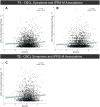This is a preprint.
Distinct Neurodevelopmental Signatures of Sex-Specific Transcriptome-Based Polygenic Risk Scores for Depression
- PMID: 40766156
- PMCID: PMC12324647
- DOI: 10.1101/2025.07.31.25332511
Distinct Neurodevelopmental Signatures of Sex-Specific Transcriptome-Based Polygenic Risk Scores for Depression
Abstract
Major depressive disorder (MDD) impacts females and males differently and post-mortem gene expression profiling reveals distinct transcriptomic signatures of the disorder in each sex. Using genes that are transcriptionally altered in MDD in both sexes, we recently developed a novel transcriptome-based polygenic risk score (tPRS), which had sex-specific associations with brain structure and depressive symptoms in both adolescents and adults. Identifying the neurodevelopmental signatures of genetically-induced shifts toward a depression-like brain transcriptome in each sex during a crucial stage, when sex differences in MDD vulnerability initially manifest, could provide useful information about the developmental pathways of early MDD risk. Leveraging sex-specific MDD gene expression data, we sought to develop female- and male-specific tPRSs (tPRS-F and tPRS-M, respectively) and evaluate their impact on regional cortical thickness, cortical surface area, subcortical volume, and depressive symptoms at baseline and 2-year follow-up in a developmental sample of 5002 adolescents (46.6% female, aged 8.9-11.0). In males, tPRS-M was associated with higher depressive symptoms at both timepoints and thicker left posterior cingulate at follow-up. In females, tPRS-F was associated with lower volumes of the right accumbens area, right caudate, and bilateral hippocampi at follow-up. Subcortical volumes of the right caudate and right hippocampus further mediated an indirect effect of tPRS-F on depressive symptoms. For each sex-specific PRS, no effects emerged in the opposite sex. Our findings suggest that sex-specific depression-like shifts in gene expression may contribute to unique vulnerability phenotypes for future MDD risk via distinct mechanisms in each sex.
Figures



References
-
- American Psychiatric Association. Diagnostic and statistical manual of mental disorders. 5th ed. Washington, D.C.; 2013.
-
- Kalin NH. The critical relationship between anxiety and depression. AJP. 2020;177:365–367. - PubMed
-
- Brown TA, Campbell LA, Lehman CL, Grisham JR, Mancill RB. Current and lifetime comorbidity of the DSM-IV anxiety and mood disorders in a large clinical sample. Journal of Abnormal Psychology. 2001;110:585–599. - PubMed
-
- Judd LL, Kessler RC, PauIus MP, Zeller PV, Wittchen H -U., Kunovac JL. Comorbidity as a fundamental feature of generalized anxiety disorders: Results from the National Comorbidity Study (NCS). Acta Psychiatr Scand. 1998;98:6–11. - PubMed
-
- Kessler RC, Berglund P, Demler O, Jin R, Merikangas KR, Walters EE. Lifetime prevalence and age-of-onset distributions of DSM-IV disorders in the national comorbidity survey replication. Arch Gen Psychiatry. 2005. Jun;62(6):593–602. - PubMed
Publication types
Grants and funding
- U24 DA041147/DA/NIDA NIH HHS/United States
- U01 DA051039/DA/NIDA NIH HHS/United States
- U01 DA041120/DA/NIDA NIH HHS/United States
- U01 DA051018/DA/NIDA NIH HHS/United States
- U01 DA041093/DA/NIDA NIH HHS/United States
- U24 DA041123/DA/NIDA NIH HHS/United States
- U01 DA051038/DA/NIDA NIH HHS/United States
- U01 DA051037/DA/NIDA NIH HHS/United States
- U01 DA051016/DA/NIDA NIH HHS/United States
- U01 DA041106/DA/NIDA NIH HHS/United States
- U01 DA041117/DA/NIDA NIH HHS/United States
- U01 DA041148/DA/NIDA NIH HHS/United States
- U01 DA041174/DA/NIDA NIH HHS/United States
- U01 DA041134/DA/NIDA NIH HHS/United States
- U01 DA041022/DA/NIDA NIH HHS/United States
- U01 DA041156/DA/NIDA NIH HHS/United States
- U01 DA050987/DA/NIDA NIH HHS/United States
- U01 DA041025/DA/NIDA NIH HHS/United States
- U01 DA050989/DA/NIDA NIH HHS/United States
- U01 DA041089/DA/NIDA NIH HHS/United States
- U01 DA050988/DA/NIDA NIH HHS/United States
- U01 DA041028/DA/NIDA NIH HHS/United States
- U01 DA041048/DA/NIDA NIH HHS/United States
LinkOut - more resources
Full Text Sources
